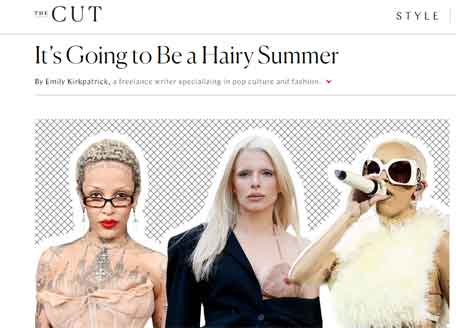
Like a lot of other women my age, I grew up reading fashion magazines like Seventeen, Glamour, Mademoiselle and Vogue. I loved looking at designer clothing and reading about the newest styles and the latest makeup, health and beauty tips.
But in the late 1980s and early '90s, things began to change. Models — always thin — became emaciated and androgynous, their poses awkward and contorted. The clothes were ugly and unflattering. (My mother, a strikingly beautiful woman with elegant taste, commented at the time, "Designers used to love women, and it showed. Today's styles make it look as if they hate us.") And the focus on beauty and health morphed into a constant running celebration of sexual excess and abortion, with frequent criticism of men tossed in for good measure. ("Feminism," you know.)
By my late 20s, I'd stopped buying fashion magazines altogether and switched to home and decor publications, where I could explore beauty and creativity without being relentlessly assaulted by left-wing politics or the rallying cry that the high-water mark of womanhood is the ability to destroy our own children.
I've nevertheless checked in on the decline of beauty in the beauty magazines over the years — typically while stuck at the salon in highlighting foils. (In fact, most fashion magazines no longer even exist in print. Mademoiselle ceased printing in 2001, Self in 2017, Seventeen in 2018, Glamour in 2019, Allure in 2022. Vogue still publishes 10 print issues annually.) I've watched as the standards got lower and lower. You find yourself thinking, "My God, they can't get worse." And then they do.
Case in point? Last week, The Cut, New York magazine's woman-focused online publication, featured an article titled, "It's Going to Be a Hairy Summer."
Guess what hair they're talking about?
The accompanying photos are the big reveal: musical artist Doja Cat wearing schoolmarmish glasses and a clingy, flesh-toned, see-through gown with a neckline so low that both areolae are partially exposed. She is naked underneath, with her pubic hair clearly visible through the sheer skirt. Actress, model and designer Julia Fox is sporting a bikini bottom decorated to look like the front of a woman's genitals — stitched shut, with the word "closed" written above it.
This is, apparently, what passes for astute social commentary in the Met Gala social set. In an interview with Glamour, Fox described her outfit and bleached eyebrows as "man repellent" and eschewed heterosexual relationships, opining that a wife and a prostitute "are both doing the same thing."
The Cut article's author, Emily Kirkpatrick, explains these daring sartorial choices: "Given the increasingly nude direction the red carpet has been headed in recent years ... stars are forced to go in all-new fashion extremes to generate the same press they've become accustomed to." Thus, the recent "exposed butt-crack trend" was quickly followed by full-frontal nudity.
Call this what it is — it isn't fashion; it's filth. It isn't art; it's tasteless trash. It requires neither imagination nor talent, and it certainly isn't progressive. Women with few economic options and fewer moral inhibitions have been flashing their parts since humanity first discovered them. Whoop-de-doo.
What's truly offensive is the way our artistic class — designers, performers, media personalities and other celebrities — make every imaginable attempt to normalize this descent into depravity. And they frequently ascribe to the general population preferences that likely don't extend to the rest of us.
For example, Kirkpatrick writes, "by the early aughts, women of all ages had become convinced that they should be completely bald down there."
Really? Most women don't think looking like a naked 10-year-old makes them sexy or desirable. Nor are most men sexually attracted to little girls. But it does make one wonder about the goings-on among America's elites in Hollywood and elsewhere: the popularity of pimps like Jeffrey Epstein, the whispered rumors of pedophilia rings, and the shocking marketing campaigns like Balenciaga's in 2022, which featured toddlers holding stuffed toys in bondage gear.
Kirkpatrick acknowledges that women who aren't rich or famous may simply be foregoing their hair removal to save money. Others, she hypothesizes, may be trying to "excise men from their lives entirely."
"Whatever the reason," she gleefully concludes, "it's clear that whether you wear it untamed, landing stripped, or full Brazilian, there's no wrong way to flaunt your pubic hair in public this summer."
There's the message.
And, dear reader, lest you continue to labor under the impression that all this explicit content is directed solely at "grownups," let me disabuse you of that misconception.
The magazine Teen Vogue — whose target audience is girls 11 to 19 — has featured wholesome content like "What to Get a Friend Post-Abortion" (Sample advice: "So your friend is about to have an abortion. ... Look, making this decision is never simple, and having to make it as a teenager is more than a little terrifying. ... She will need a ride, she will need a hug, and she will need you — not because the act itself is so terrible, but because sometimes the world can be.")
And then there were the articles normalizing prostitution and promoting anal sex. The latter piece not only tried to gloss over the gag factor ("Yes, there might be some poop") but also enraged feminists because author Gigi Engle refused to use the terms "men and women," preferring "prostate owners" and "non-prostate owners." (Query: How does one "own" a "non-prostate"?)
The decline in social standards caused by the relentless pursuit of "shock value" continues because we've tolerated it. Most of us don't wear labels like Balenciaga, so we can't boycott them. But we can put the economic thumbscrews to the celebrities who do patronize this garbage, as well as the publications that promote it and companies whose advertisements provide financial support.
It's time to stand up.
(COMMENT, BELOW)
Laura Hollis is an attorney and academic. She resides in Indiana with her husband and their two children.


 Contact The Editor
Contact The Editor
 Articles By This Author
Articles By This Author